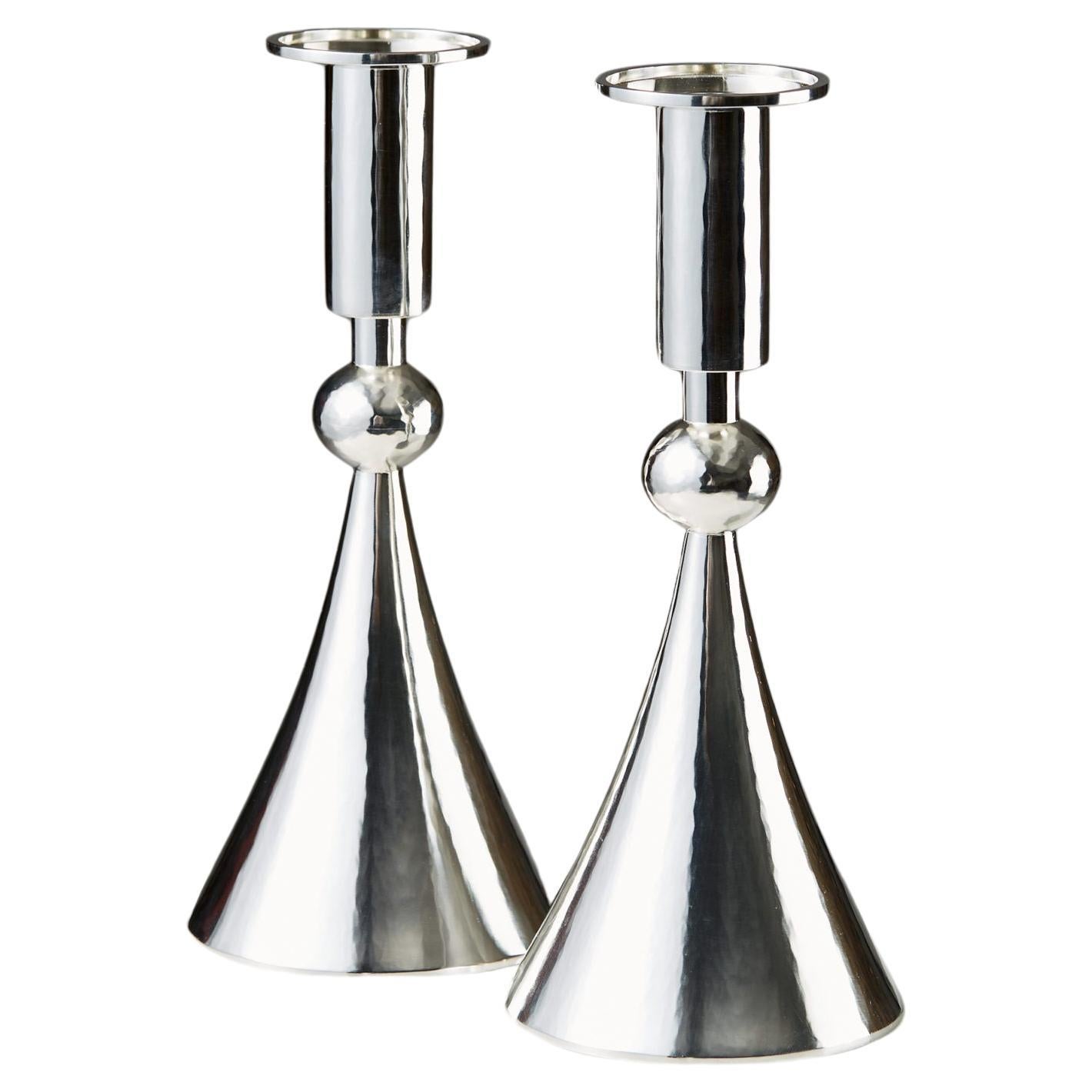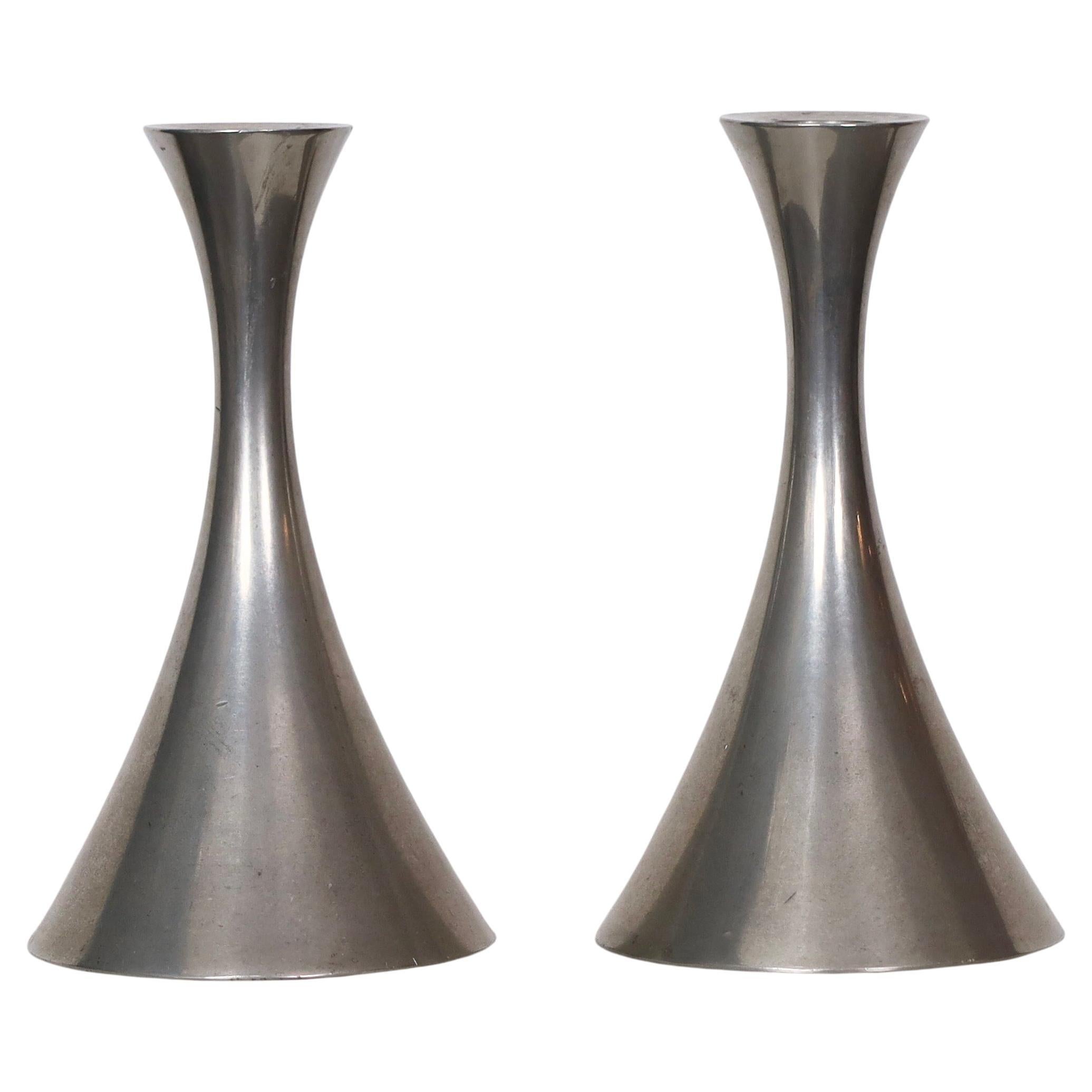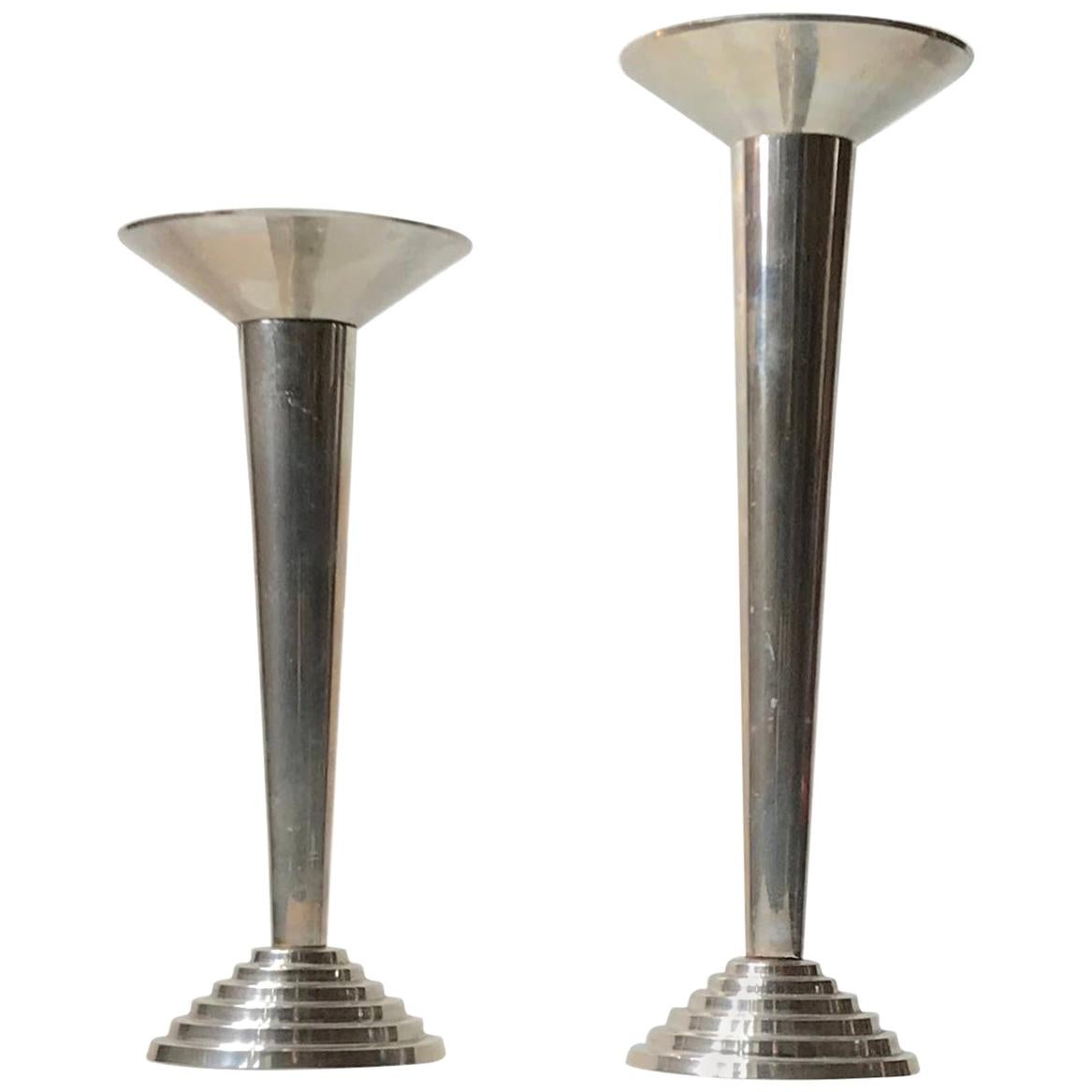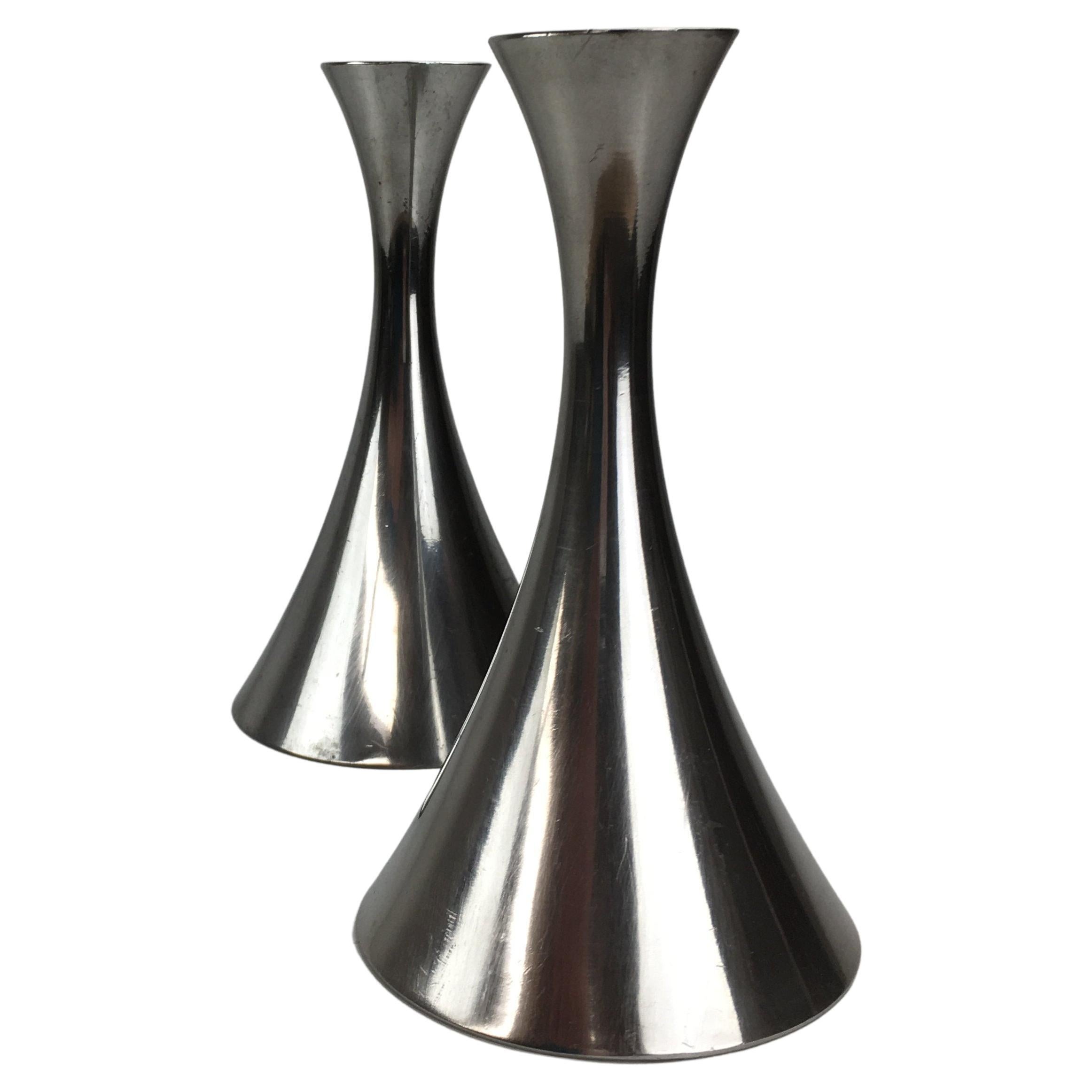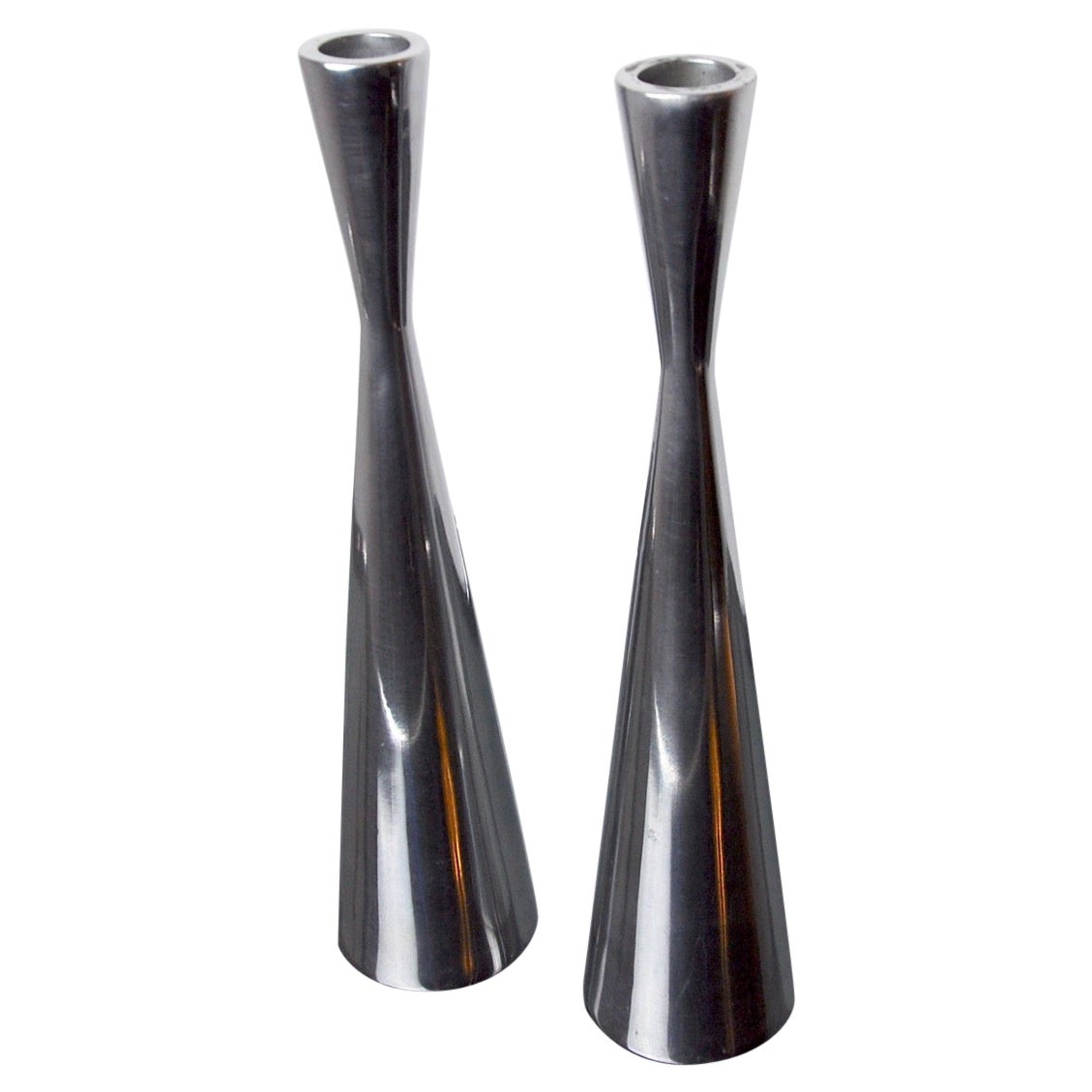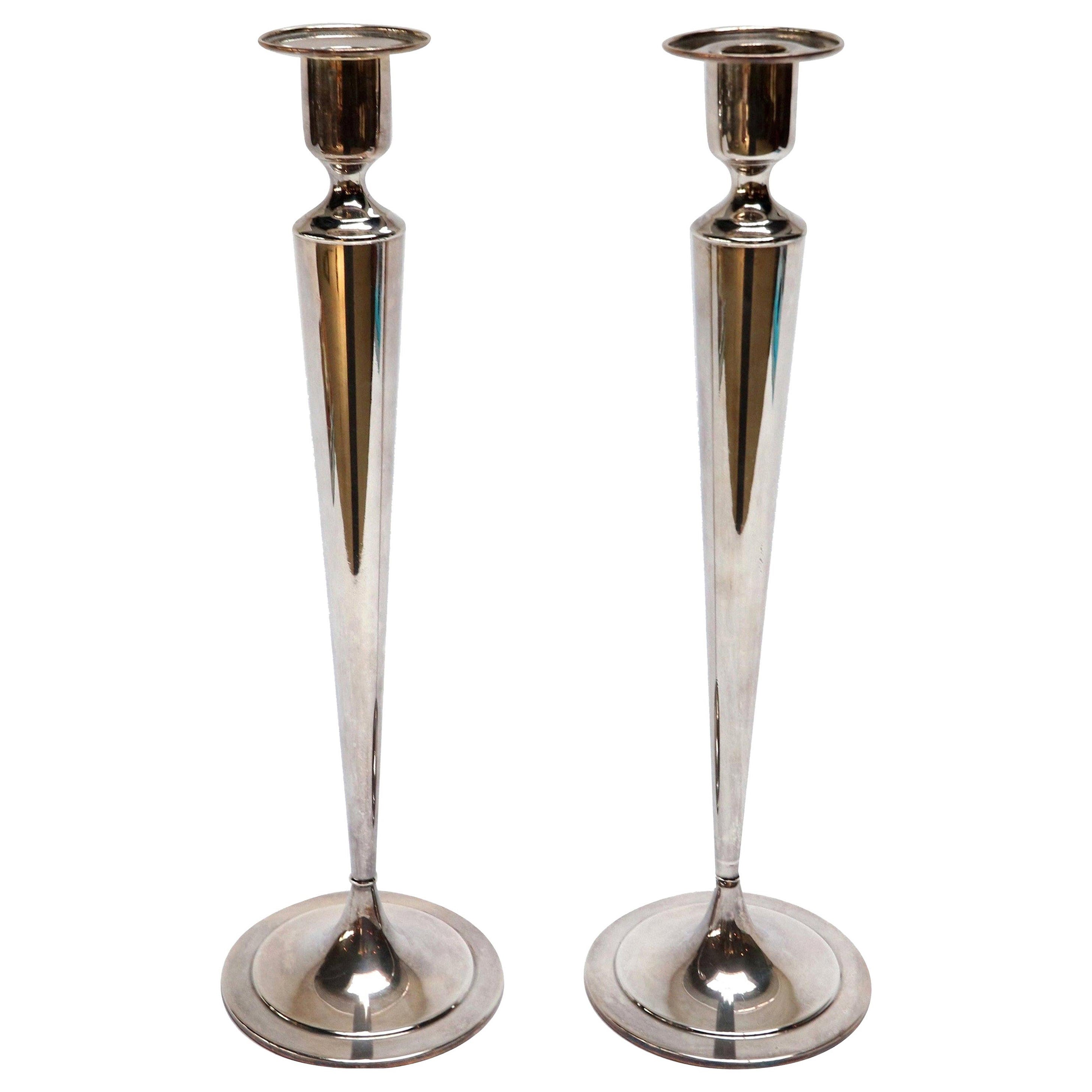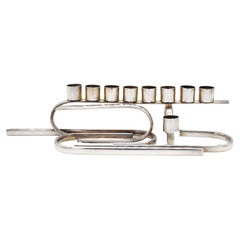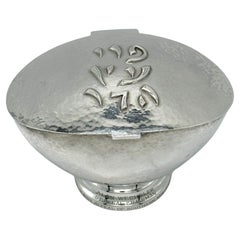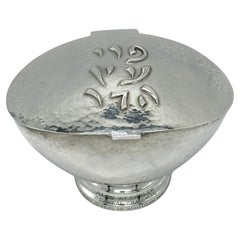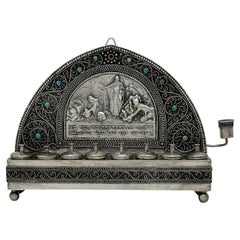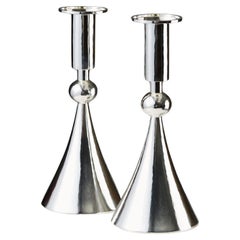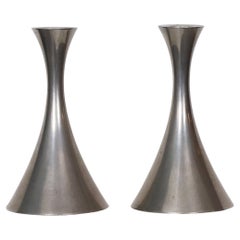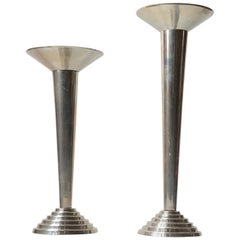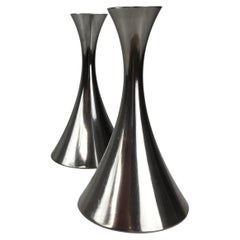Items Similar to Pair of David Heinz Gumbel silver candlesticks, modern Judaica, Bauhaus style
Want more images or videos?
Request additional images or videos from the seller
1 of 7
Pair of David Heinz Gumbel silver candlesticks, modern Judaica, Bauhaus style
$9,000per set
£6,811.61per set
€7,817.75per set
CA$12,821.25per set
A$13,904.95per set
CHF 7,303.41per set
MX$168,899.15per set
NOK 91,390.57per set
SEK 86,049.33per set
DKK 58,389.80per set
About the Item
We are offering here this perfectly designed pair of sterling silver candlesticks, all hand Hammered in a fine and sleek Bauhaus design, the candlesticks were made after Gumbel Left his work in the bezalel school of arts in Jerusalem, they date from the 60s'.
This pair will be an amazing addition to any Judaica or silver collection, and will be Amazing in any house with their Bauhaus, delicate hammered sleek design.
The candlesticks are both marked 925 for sterling silver and the latter "G" in Hebrew for "Gumbel"
Measurements:
Height : 9.7 inch / 24.8 cm
Width : 3.6 inch / 9.1 cm
Master silversmith David Heinz Gumbel, was born in Sinsheim, Germany, near Heidelberg. He studied at the Kunstgewerbeschule in Berlin-Charlottenberg from 1927 to 1931. Although Gumbel did not actually study at the Bauhaus, he was profoundly Influenced by its teachings and incorporated its design aesthetic into his silver and Judaica. In 1934 Gumbel fled Nazi Germany and moved to Palestine. As a member of the Faculty of the recently opened New Bezalel School in Jerusalem, he joined a group of Highly cultured artists and colleagues who worked under the directorship of Joseph Budko, a craftsman who championed the modernist aesthetic. Gumbel taught Silversmithing, hammered work, and jewelry design at Bezalel, and retired in 1955. His Personal style always remained classic modern -- his objects emphasize streamlined Design and graceful contours.
He was born in Sinsheim to a secular family among the pioneers of the local silversmith Industry. In 1918, the Gumbels relocated to Heilbronn where David worked as an Apprentice in the "Bruckmann & Sons" factory, becoming a certified steel engraver.
In the late 1920s, Gumbel studied to be a silversmith at the school of applied arts in Berlin At the Kunstgewerbeschule. Following his studies, Gumbel was employed at workshops In Düsseldorf and Stockholm, as well as in the family factory in Heilbronn. It was there that Gumbel began to design hand-made silver pieces in the modern style. Simultaneously, He produced Jewish ritual objects like a Chanukah menorah or candlesticks. Gumbel Utilized polished silver and other materials, such as ivory, in his works.
In 1936, Gumbel left Germany for Land of Israel, joining the Bezalel Academy of Arts and Design as a teacher and the administrator of the metal department, alongside Ludwig Yehuda Wolpert. Once in the Land of Israel, Gumbel began to work with typography, Ostensibly as a result of Wolpert's influence.
Despite Gumbel's modern approach to design, he continued to work with and teach the Traditional methods of manual manufacturing, such as repoussé. In the early 1940s, he Opened an independent workshop where he produced metal works and Judaica pieces In said silversmith techniques.
Gumbel retired from his work at Bezalel in 1955. In his will Gumbel left the continuation of His creation to the artist Malka Cohavi, his assistant and teacher at Bezalel Academy of Art and Design.
- Dimensions:Height: 9.7 in (24.64 cm)Diameter: 3.6 in (9.15 cm)
- Sold As:Set of 2
- Style:Bauhaus (In the Style Of)
- Materials and Techniques:Silver,Hammered
- Place of Origin:
- Period:
- Date of Manufacture:1960s
- Condition:Wear consistent with age and use. GoodWear consistent with age and use. Perfect condition to its age, no brakes, no restorations, Some minor scratches and age related wear.
- Seller Location:Tel Aviv - Jaffa, IL
- Reference Number:1stDibs: LU8130235523792
About the Seller
No Reviews Yet
Vetted Professional Seller
Every seller passes strict standards for authenticity and reliability
1stDibs seller since 2023
- ShippingRetrieving quote...Shipping from: Tel Aviv - Jaffa, Israel
- Return Policy
Authenticity Guarantee
In the unlikely event there’s an issue with an item’s authenticity, contact us within 1 year for a full refund. DetailsMoney-Back Guarantee
If your item is not as described, is damaged in transit, or does not arrive, contact us within 7 days for a full refund. Details24-Hour Cancellation
You have a 24-hour grace period in which to reconsider your purchase, with no questions asked.Vetted Professional Sellers
Our world-class sellers must adhere to strict standards for service and quality, maintaining the integrity of our listings.Price-Match Guarantee
If you find that a seller listed the same item for a lower price elsewhere, we’ll match it.Trusted Global Delivery
Our best-in-class carrier network provides specialized shipping options worldwide, including custom delivery.More From This Seller
View AllSilver Hanukkah Lamp made by Eli Gera, modern Judaica, Israel, Tel Aviv 1970s.
Located in Tel Aviv - Jaffa, IL
Very rare and important piece of Israeli modern Judaica, a bauhaus style silver Hanukkah Lamp made by the famous jewish silversmith Eli Gera, made from hand bent And hand Forged silver in the 70s, while other works by Gera were multiplied by him, from What we Know this piece is a one of a kind.
Marked "SILVER 925" and ELI GERA in Hebrew and English
on a small silver plaque on the base.
Measurements:
Height: 3 inch / 7.6 cm
Width: 11.8 inch / 30 cm
Depth : 3.3 inch / 8.5 cm
Condition :
Perfect condition for its age, no brakes, no restorations, some minor scratches and age Related wear
About the artist :
Please note the Victoria & Albert Museum in London holds an Hanukkah lamp Havdalah Set...
Category
Vintage 1970s Israeli Bauhaus Sterling Silver
Materials
Silver
JUDAICA SILVER ETROG BOX DESIGNED BY LUDWIG WOLPERT. New York, 20th century
By Ludwig Yehuda Wolpert
Located in Tel Aviv - Jaffa, IL
This charming piece of jewish history in front of you is a one of kind modern Judaica object, This box used to hold the Etrog To protect the it during the holiday of Sukkot, it is traditionally Wrapped in silky flax fibers and stored in a special decorative box, mostly made from silver. Wolpert designed this amazing hand hammered Bauhaus style box in 1963-1964 while he was Working in New York. all of the boxes we could found from this design made by Wolpert have The upper part inscribed in a simple engraving with the phrase "Pri Etz Hadar" In Hebrew ״פרי עץ הדר״. the box in front of you is the only example in existence as far as we Know where the letters are also repoussé and also engraved, such a beautiful and hard to get Combination, the rest of the box is shaped as a modernistic Etrog, all the body of the box is Skillfully hand hammered in a way it reflects the light in a warm and calm way, a true Masterpiece of modern judaica by the great and important artist Ludwig Yehuda Wolpert. One of the the two great masters of 20th century Judaica. the Box is marked "WOLPERT" AND "STERLING" and the base has the engraved inscription : "ALAN WECHSLER GENERAL CHAIRMAN, ALLIED JEWISH APPEAL OF SOUTHERN NEW JERSEY 1978"
Similar boxes can be find in museum collections around the world
In the Jewish Museum New York
In the North Carolina Museum of Art
In The Derfner Judaica Museum
Another similar box was featured in the Israel Museum exhibition "Forging Ahead, Wolpert and Gumbel, Israeli Silversmiths for the Modern Age"
sizes:
Height: 4 in (10.16 cm)
Width: 6.1 in (15.5 cm)
Depth: 4.4 in (11.18 cm)
Weight :
Ludwig Yehuda Wolpert was born in Hildesheim, Germany, to an Orthodox family. In 1916-1920, He began his studies in sculpture at the Frankfurt School of Art. In 1925-1928, he studied Goldsmithing at the Frankfurt School of Art. Following the presentation of the works in the 1930 exhibition "Kult und Form" ("Ritual and Form") at the Jewish Museum in Berlin, his works became well known in the German Jewish World. His works were greatly influenced by Modernist design, especially the Bauhaus Movement. Wolpert's works avoid decoration, relying on clean, geometric shapes. In 1933, Following the Nazi rise to power in Germany, he immigrated to the Mandatory Palestine with His family. There he worked for two years in the workshop of Bernhard Friedländer, where he Designed and produced silverware and Jewish ceremonial art.Together with Victor Solomon...
Category
Vintage 1970s American Bauhaus Decorative Boxes
Materials
Silver
JUDAICA SILVER ETROG BOX DESIGNED BY LUDWIG WOLPERT. New York, 20th century
Located in Tel Aviv - Jaffa, IL
This charming piece of jewish history in front of you is a one of kind modern Judaica object,
This box used to hold the Etrog To protect the it during the holiday of Sukkot, it is traditionally Wrapped in silky flax fibers and stored in a special decorative box, mostly made from silver.
Wolpert designed this amazing hand hammered Bauhaus style box in 1963-1964 while he was Working in New York. all of the boxes we could found from this design made by Wolpert have The upper part inscribed in a simple engraving with the phrase "Pri Etz Hadar"
In Hebrew ״פרי עץ הדר״. the box in front of you is the only example in existence as far as we Know where the letters are also repoussé and also engraved, such a beautiful and hard to get Combination, the rest of the box is shaped as a modernistic Etrog, all the body of the box is Skillfully hand hammered in a way it reflects the light in a warm and calm way, a true Masterpiece of modern judaica by the great and important artist Ludwig Yehuda Wolpert.
One of the the two great masters of 20th century Judaica.
the Box is marked "WOLPERT" AND "STERLING" and the base has the engraved inscription :
"ALAN WECHSLER GENERAL CHAIRMAN, ALLIED JEWISH APPEAL OF SOUTHERN NEW JERSEY 1978"
Similar boxes can be find in museum collections around the world
In the Jewish Museum New York
In the North Carolina Museum of Art
In The Derfner Judaica Museum
Another similar box was featured in the Israel Museum exhibition
"Forging Ahead, Wolpert and Gumbel, Israeli Silversmiths for the Modern Age"
Ludwig Yehuda Wolpert was born in Hildesheim, Germany, to an Orthodox family. In 1916-1920, He began his studies in sculpture at the Frankfurt School of Art. In 1925-1928, he studied Goldsmithing at the Frankfurt School of Art.
Following the presentation of the works in the 1930 exhibition "Kult und Form" ("Ritual and Form") at the Jewish Museum in Berlin, his works became well known in the German Jewish World. His works were greatly influenced by Modernist design, especially the Bauhaus Movement. Wolpert's works avoid decoration, relying on clean, geometric shapes. In 1933, Following the Nazi rise to power in Germany, he immigrated to the Mandatory Palestine with His family. There he worked for two years in the workshop of Bernhard Friedländer, where he Designed and produced silverware and Jewish ceremonial art.Together with Victor Solomon...
Category
Vintage 1960s Decorative Boxes
Materials
Silver
Bezalel Jerusalem silver Hanukah lamp set with stones, Yehia Yemini circa 1920s
Located in Tel Aviv - Jaffa, IL
A Silver Hanukkah lamp crafted by Yehia Yemini in Jerusalem circa 1920 is a fascinating piece of Judaica. Yehia Yemini was known for his intricate and detailed silverwork. This lamp ...
Category
Vintage 1920s Candle Lamps
Materials
Multi-gemstone, Sterling Silver
Early 20th Century Silver Spice Tower by Yehia Yemini, Bezalel School Jerusalem
Located in Tel Aviv - Jaffa, IL
Very rare Bezalel Jerusalem silver filigree spice tower, this amazing spice Tower was Made by Yehia Yemini, who was the best filigree artist in bezal...
Category
Vintage 1920s Israeli Sterling Silver
Materials
Silver
Important Early 20th Century Silver Kiddush Goblet by Bezalel School Jerusalem
Located in Tel Aviv - Jaffa, IL
Important Handmade sterling silver Kiddush goblet by Bezalel School, Jerusalem, circa 1910-1913.
On round base decorated with silver filigree and Cabouchon shaped green agate applications.
The base fitted with Bezalel mark. The upper portion is all adorned with amazing filigree work, the base and the actual cup adorned with swirling filigree designs, in the middle there are 3 roundels, made in another technique of hammered silver, similar to the works that were produced in this time all over Europe, in the middle of each roundel there is a perfectly centered Cabouchon green agate.
This work is attributed to Yehia Yemini.
The goblet is marked on the base, with the earliest silver mark of the school that just say "Bezalel" in Hebrew.
Yehia Yemini :
Was one of the biggest and must famous Bezalel silver...
Category
Early 20th Century Israeli Jugendstil Sterling Silver
Materials
Silver
You May Also Like
Pair of Candlesticks Designed by Sigurd Persson, Sterling Silver, Sweden, 1964
By Sigurd Persson
Located in Stockholm, SE
Pair of candlesticks designed by Sigurd Persson,
Sweden. 1964.
Sterling silver.
Measurements:
H: 21.5 cm/ 8 1/2"
D: 9.3 cm / 3 2/4"
Category
Vintage 1960s Swedish Scandinavian Modern Candlesticks
Materials
Silver, Sterling Silver
Pewter Candlestick Holders by Arne Erkers for Just Andersen, 1950s, Denmark
By Just Andersen
Located in Værløse, DK
Set of Pewter Candlestick Holders designed by Arne Erkers for Just Andersen in 1952. An elegant set for a beautiful place.
* Set of round Candleholders in Pewter
* Designer: Arne Er...
Category
Vintage 1950s Danish Art Deco Candlesticks
Materials
Metal, Pewter
Art Deco Candlesticks in Steel, Germany, 1930s
Located in Esbjerg, DK
A set of Art Deco styled candlesticks. 'Staired' architecturally inspired base in engine turned aluminium. The tubes and candle holder are stan...
Category
Vintage 1930s German Bauhaus Candlesticks
Materials
Aluminum, Stainless Steel
$330 Sale Price / set
20% Off
1940s Set of Two Danish Just Andersen Circular Pewter Candle Holders
By Just Andersen
Located in Knebel, DK
Set of two Danish Just Andersen art deco pewter candle holders produced by Just Andersen A/S in the 1930's.
The candle holders are in good vintage condition and marked with Just. ...
Category
Vintage 1940s Danish Art Deco Candlesticks
Materials
Metal, Pewter
Pair of Scandinavian Diabolo Candle Holders, Aluminum, Sweden, circa 1970
Located in BARCELONA, ES
Superb pair of scandinavian diabolo candle holders designed and produced in finland in the 1970s.
Design objects in aluminum attributed to the famous finnish designer Tapio Wirkka...
Category
Vintage 1970s Scandinavian Hollywood Regency Candlesticks
Materials
Metal, Aluminum
Pair of Silver Fairpoint Candlesticks, 1960s
Located in Los Angeles, CA
Pair of 1960s silver plated fairpoint candlesticks. Elegant, beautiful addition to a modern home.
Category
Vintage 1960s American Mid-Century Modern Candle Holders
Materials
Silver Plate
$1,800 / set
More Ways To Browse
Ritual Objects
Silver Judaica
Judaica And Silver
Menorah Candlestick
Ludwig Yehuda Wolpert
David Heinz Gumbel
Judaica Candlestick
Colonial Brass Candlestick
Egypt Candlesticks
Repousse Candlesticks
Snake Candle Holder
Wall Candle Holders By Pierre Forssell
17th Century Bronze Candlestick
Antler Candlestick Holders
Cobalt Blue Candle
Corinthian Silver Candlesticks
Griffin Feet
Spiral Candle Holder
